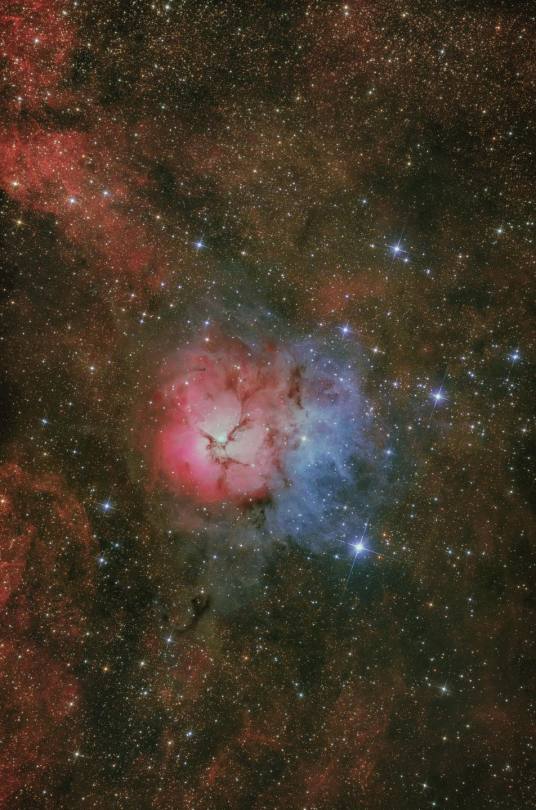Energetic Light & Winds From Newborn Stars In Carina Nebula ©

Energetic light & winds from newborn stars in Carina Nebula ©
More Posts from Dukeofwatts and Others

Strike a pose, vogue! 📸
The galaxy on the left looks like it went with extreme eye makeup, while the one on the right went with a more natural look. Together, they’re known as Arp 107, a pair of colliding galaxies.
The glamorous galaxy on the left is an extremely energetic galaxy with a very active core. Its small companion is connected to it by a faint “bridge” of gas and dust. This view was captured by the Hubble Space Telescope.
Credit: ESA/Hubble & NASA, J. Dalcanton.
ALT TEXT: A pair of merging galaxies. The galaxy on the left has a single, large spiral arm curving out from the core toward 3 o’clock and wrapping counterclockwise, ending in a straighter line pointing toward the bottom of the frame. This arm is bright blue with shades of brown mixed in. The right-hand galaxy has a bright core that is approximately the same size as the galaxy at left, but only a tiny bit of very faint material surrounds it. A broad curtain of gas connects the two galaxies’ cores and hangs beneath them. Small stars and galaxies are scattered throughout the black background of space.








We are truly children of the stars. —Brian Cox
l all taken by David Moulton




Abell 21, Medusa Nebula, Dreadful Beauty

A photo taken by the James Webb Space Telescope shows the distorted spiral galaxy at center, the Penguin, and the compact elliptical galaxy at left, the Egg, locked in an active embrace.

Pleiades Star Cluster

The Blinking Planetary Nebula, NGC 6826 // Dionysus



Saturn by NASA (2019

Comet McNaught and the Milky Way

Chandra Sees the Peacock’s Galaxy ©

A cosmic heart shape caused by colliding galaxies.
-
 jerryfuller-blog reblogged this · 2 months ago
jerryfuller-blog reblogged this · 2 months ago -
 jerryfuller-blog liked this · 2 months ago
jerryfuller-blog liked this · 2 months ago -
 took-the-midnight-train reblogged this · 6 months ago
took-the-midnight-train reblogged this · 6 months ago -
 akauauki reblogged this · 6 months ago
akauauki reblogged this · 6 months ago -
 akauauki liked this · 6 months ago
akauauki liked this · 6 months ago -
 omniuniversal1221241109am reblogged this · 6 months ago
omniuniversal1221241109am reblogged this · 6 months ago -
 omniuniversal1221241109am liked this · 6 months ago
omniuniversal1221241109am liked this · 6 months ago -
 the-knitting-cat liked this · 8 months ago
the-knitting-cat liked this · 8 months ago -
 divavoid reblogged this · 8 months ago
divavoid reblogged this · 8 months ago -
 aliceabsinthe liked this · 8 months ago
aliceabsinthe liked this · 8 months ago -
 myfavoriteshow reblogged this · 8 months ago
myfavoriteshow reblogged this · 8 months ago -
 myfavoriteshow liked this · 9 months ago
myfavoriteshow liked this · 9 months ago -
 messier47 reblogged this · 10 months ago
messier47 reblogged this · 10 months ago -
 spira---mirabilis reblogged this · 10 months ago
spira---mirabilis reblogged this · 10 months ago -
 spira---mirabilis liked this · 10 months ago
spira---mirabilis liked this · 10 months ago -
 greywolf117 reblogged this · 10 months ago
greywolf117 reblogged this · 10 months ago -
 greywolf117 liked this · 10 months ago
greywolf117 liked this · 10 months ago -
 lightofearendil liked this · 10 months ago
lightofearendil liked this · 10 months ago -
 supermansavemee reblogged this · 10 months ago
supermansavemee reblogged this · 10 months ago -
 asyouare19 reblogged this · 10 months ago
asyouare19 reblogged this · 10 months ago -
 onecallaway19 reblogged this · 10 months ago
onecallaway19 reblogged this · 10 months ago -
 antojane reblogged this · 11 months ago
antojane reblogged this · 11 months ago -
 angelbehindu liked this · 11 months ago
angelbehindu liked this · 11 months ago -
 i-iii-iii-vii liked this · 11 months ago
i-iii-iii-vii liked this · 11 months ago -
 reddofukkosu reblogged this · 1 year ago
reddofukkosu reblogged this · 1 year ago -
 reddofukkosu liked this · 1 year ago
reddofukkosu liked this · 1 year ago -
 dbeatoff reblogged this · 1 year ago
dbeatoff reblogged this · 1 year ago -
 brieftidal liked this · 1 year ago
brieftidal liked this · 1 year ago -
 orderdchaosthings2 liked this · 1 year ago
orderdchaosthings2 liked this · 1 year ago -
 final-saiyan reblogged this · 1 year ago
final-saiyan reblogged this · 1 year ago -
 final-saiyan liked this · 1 year ago
final-saiyan liked this · 1 year ago -
 brosif40 reblogged this · 1 year ago
brosif40 reblogged this · 1 year ago -
 brosif40 liked this · 1 year ago
brosif40 liked this · 1 year ago -
 bi-hans liked this · 1 year ago
bi-hans liked this · 1 year ago -
 heraldwings liked this · 1 year ago
heraldwings liked this · 1 year ago -
 spoiledcherry reblogged this · 1 year ago
spoiledcherry reblogged this · 1 year ago -
 fentanyl-rabbits reblogged this · 1 year ago
fentanyl-rabbits reblogged this · 1 year ago -
 fentanyl-rabbits liked this · 1 year ago
fentanyl-rabbits liked this · 1 year ago -
 andromeda-astrology reblogged this · 1 year ago
andromeda-astrology reblogged this · 1 year ago -
 ageofwater reblogged this · 1 year ago
ageofwater reblogged this · 1 year ago -
 thomasswift85 reblogged this · 1 year ago
thomasswift85 reblogged this · 1 year ago -
 thirtysixgnomes reblogged this · 1 year ago
thirtysixgnomes reblogged this · 1 year ago -
 demichrising liked this · 1 year ago
demichrising liked this · 1 year ago -
 fuctaculon reblogged this · 1 year ago
fuctaculon reblogged this · 1 year ago